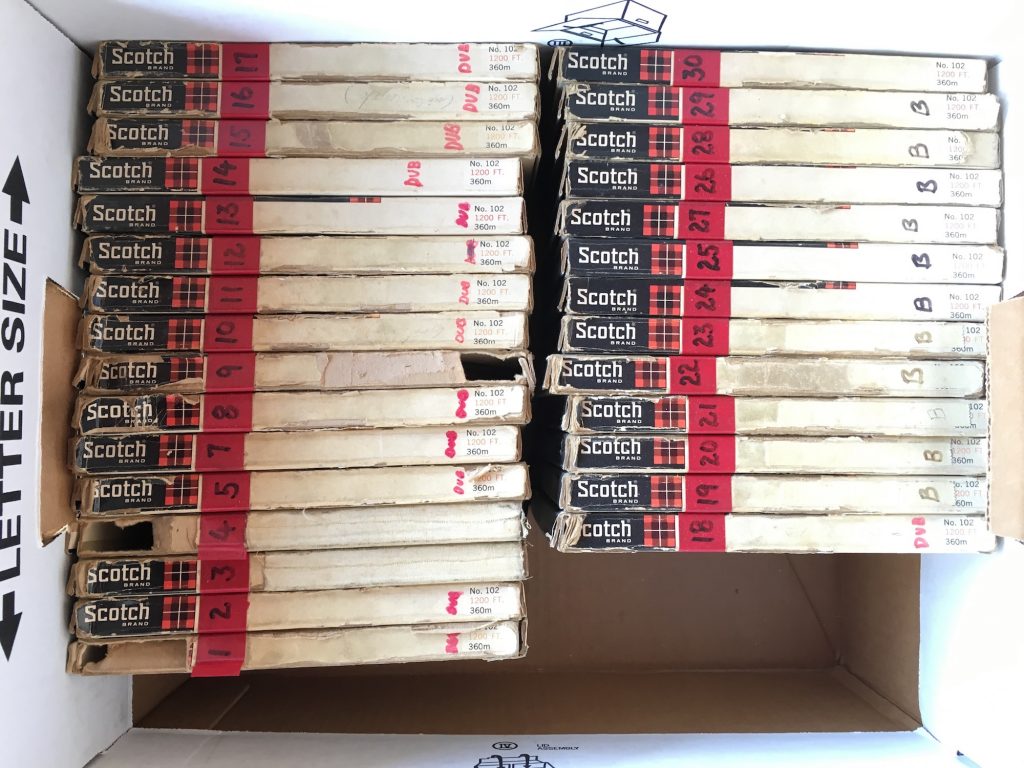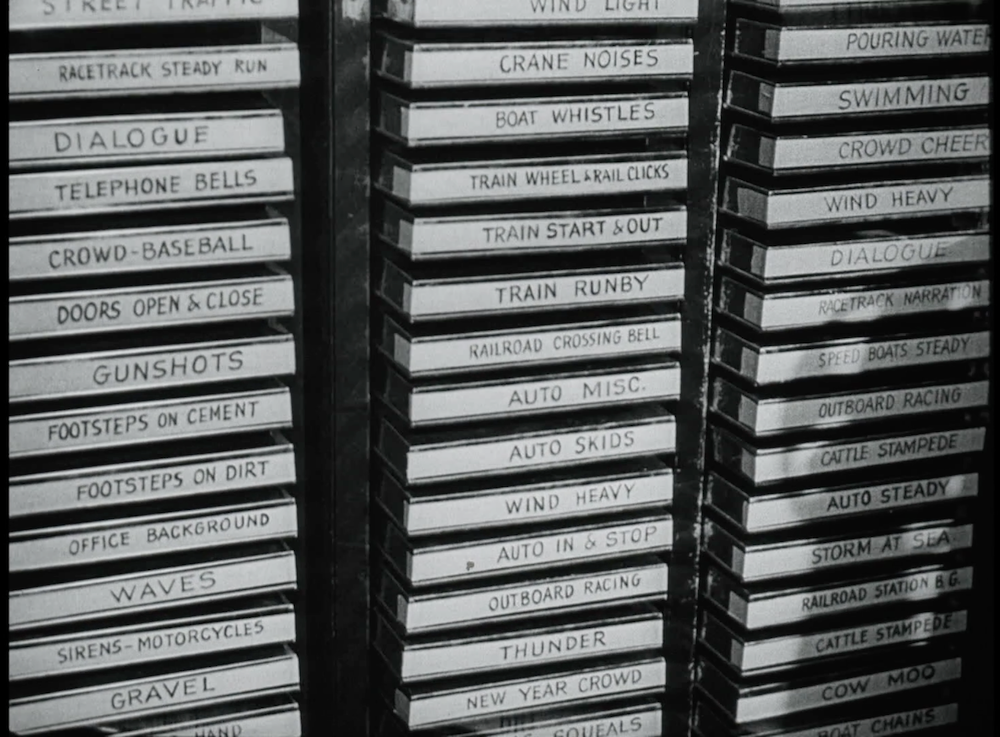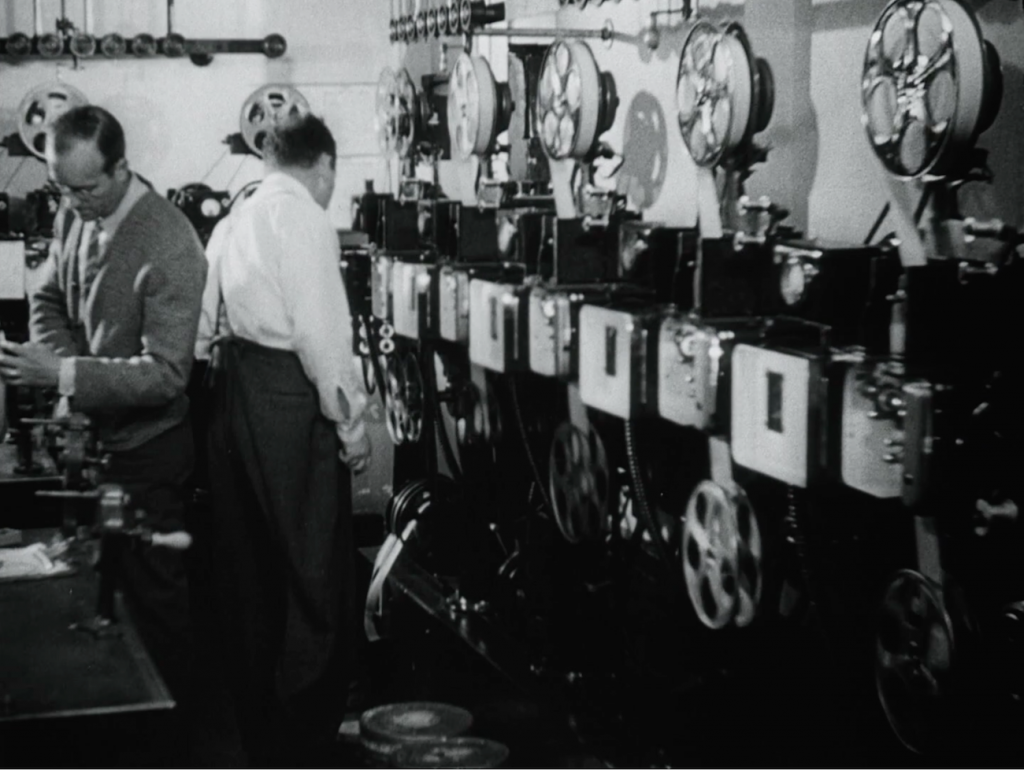[Guest blog post by Craig Smith]
In August of 2018, I uploaded 1,233 vintage optical sound effects from various Hollywood productions ranging from the 1930s to 1950s. I called the collection “the Gold Library” because of the color of the old Dyno label-maker tapes on the boxes.
Since then, I have continued to preserve the former USC optical sound effects library. And now I’m extremely happy to present the next collection of 1,554 classic sound effects: The Red Library.

Where did these come from?
To recap, I acquired these sounds from the USC Hugh M. Hefner Moving Image Archive in 2016, just before they were to be thrown away. They are first generation full-track 1/4″ tape transfers of 35mm optical sound effects. For more information on this project, Please see my February 2019 Blog post: https://blog.freesound.org/?p=901)
What’s the difference between the Gold and Red Libraries?
Although the specific origins of these sounds are mostly lost, It has become clear to me that the Gold effects were mostly clean “master” effects that were used to print copies to be cut into a film’s soundtrack. The effects in this new Red Library are not as clean, and have many splices, indicating they have been a direct part of the editing process. I’ve nicknamed this library “the workbench collection”, because these sounds are clearly leftovers from several Hollywood productions.
What’s the difference between master and working copies?
Until the mid 1950s, sounds for film were recorded onto 35mm film by modulating a beam of light.

This was a delicate process that required extremely accurate exposure and developing. These tracks could be either variable area or variable density. Both had advantages and disadvantages.

These master tracks would then be duplicated for editors, cut into individual sounds, and wound into small rolls held by rubber bands or paper tape. They were then placed into “trim boxes” for easy access.

The sounds could be retrieved by editors and edited on a Moviola editing machine As they cut effects, they would return the leftover bits, the “trims”, to the trim boxes.

The sounds were edited onto reels that were then put onto reels and loaded onto “dubbers” for final mixing.

This system worked well, except that every optical generation created more noise, loss of high-end, and distortion. Since the prints shown in theaters were many generations removed from the original recordings, precision in every step was incredibly important.
What happened in the editing room?

Sound editors loved to collect their favorite sounds so they could use them again and again. Sometimes they would print more copies of a sound than they needed. Everyone was fine with this, but making copies of copies could lead to degraded sound quality. They also would take the trims with them at the end of a production, even though they might be full of audible splices.
Another thing editors did was to install “portable” optical cameras in the edit room to speed up the process.

This was likely to introduce ground noise, and intermodulation distortion due to improper exposure.
So how does the Red Library sound then?
Pretty good, actually!
My original intent with this project was to preserve, not restore. But I realized that many of these sounds needed a little help. So I did some minimal restoration including hum and hiss reduction, reduction of distortion, and splice repair (gaps and clicks). Since there are over 1,500 effects in this library, the time spent on each effect was limited. But I’m happy with the results. These are very usable sounds that you won’t find anywhere else. And they layer very well with modern digital effects.
So what’s next?
There is a lot more sound to recover in this project. The Red and Gold libraries were the easy stuff. Beyond this, I’m dealing with tapes that are badly shrunken, and tapes that have sticky-shed syndrome. Since I’m the one doing the transfers, I don’t know when I will have more to share. But I know there’s good stuff in those tapes, and I’ll find a way to recover it.
Again, I want to thank those whose support has kept me going on this project: Peder Jørgensen, Christian Schaanning, Leanna Kaiser, Jesse Smith, Dino Everett, Ben Burtt, Frederic Font, Randy Haberkamp, and Lynn Becker.
And a reminder to tell all your friends: Whenever you record a cool sound, upload it to Freesound! It’s the quickest and easiest way to achieve immortality!
– Craig Smith
Craig Smith’s Biography
Craig Smith has been recording and manipulating sound since 1964. After graduating from USC’s School of Cinematic Arts, he worked as a sound editor and production mixer in Hollywood, specializing in noisy action-adventure films that are blamed for the downfall of society. He left that world in 1986 to teach at California Institute of the Arts, where he is now Academic Sound Coordinator in the School of Film/Video.
Craig’s own work experiments with implied narrative and accidental sound design, putting together sounds & images that have nothing to do with each other to create unexpected stories.
Craig is a member of the Society of Motion Picture and Television Engineers, and the Audio Engineering Society.
This was a Freesound guest blog post. Do you have any project or something you’d like to share in the Freesound Blog? Let us know using our contact form

What a fantastic preservation work you are making, it ‘s so impressive. An effort deserving a big THANK YOU. If not for you “All those moments will (would) be lost in time, like tears in rain”
D
Great writeup. Love the project. Lot of great and very usable sounds. Even for modern videos. Keep up the good work.
AWESOME THANK YOUUUU
What a generous effort to contribute to this sound library. Thank you for working to see to it these golden age sound effects are not lost.
Outstanding report…thanks for preserving history!
Incredible effort and results, just an absolute endeavor that’s yielded so much. Thank to everyone involved, but most of all, TO MR. SMITH!!!!
Just a joy and a pleasure to listen to and implement.
Simply thanks for being and being Craig Smith ;=)
Thanks for your work. Love see old sound films, I not know have two way for record sound in film (I know about variable area but never see variable density before). Many sounds you save can’t record now (like traffic and car sound from 1920-1960s) and give me ideas for record local sound from this time. ?Thanks for many cool sci fi sounds from American sci fi movies!
This is pretty cool seeing how the sound effects were done in the past. thanks for the post interesting to read 😉
Great work!
Wow Craig, a lot of effort and consideration went into this. Thank you very much for preserving and archiving this. And also for the detailed explanation. This is a long way from quickly dropping in samples into the editing timeline.
Excellent article!!!
Thank you for this! Such a great resource and what an incredible history lesson!
I been looking for this, wanted to send it to my friend to read, really cool history lesson, thank you for posting this. will defo share on Facebook! 😉
Pavel from London
Craig,
I haven’t even heard, downloaded, or tried to locate either of the 2 Compilations, but I did read the comments and Intro, etc., and having grown up in Hollywood (I lived about 8-10 blocks West of La Brea on Curson, in between Hollywood Blvd and Hawthorn Ave.) and going to Bancroft Jr High (which was, at least back then, like a half block South of F.F. Coppola’s Zoetrope Studios), I had the honor of being taught by one of the best School Drama Teachers in L.A.County at the very least: Mr. Bialik (Dad of an Actress who is pretty well-known and has a Degree in Neurobiology (at least I think it’s that, or closely related to Neuroscience from UCLA [I know, USC’s rival, but hate the school, not the player]). Anyway, hoping you haven’t TL;DR’ed me yet, I appreciate your Hugely Generous gifts and was hoping to “buy you a beer or coffee.” I wondered: are you able to receive a PayPal donation?
I will get back to this site in a few days (today is 04-09-2020) or if you are able to see my email address, drop a quick note if able. And Thank You again for your awesome and priceless gifts that could have disappeared without a trace or whisper (or the most used and popular on-screen scream of the 20th and 21st centuries-I know you know the one, and maybe even who it was-I know I can’t possibly be the only movie-buff/ Audiophile who’d love to know). Anyway, Craig: I fully understand the value of the Golden and Ruby-encrusted Treasures that you have provided.
Most Respectfully,
Michael C
I just stumbled on this a couple days ago largely by a share of the wilhelm scream and i’m downloading it all. To hear some of the sfx in the clear that shaped my childhood of watching TV shows from the 60s, 70s and 80s is a just a delightful privilege, especially me as I have always considered myself a amateur sound recordist since I was a teenager and have a small collection here at freesound….and more coming once I get time to edit some.
These truly had a unique sound signature, and while digital is certainly a significant part of today, these certaintly also have merit today.
THANK YOU for your efforts in saving and preserving these sounds. At a radio station production capacity, I have saved/preserved audio that has or was about to be tossed, so I know only too well in the tape baking/transfer process and how tedious it cane me, so to devote your personal time for the efforts here, just deserves a tremendous Thanks to you and to all involved.
where might i find the Bewitched SFX magic sound effects ? Sunset Editorial had them at one point.
Wow, this is so cool! Preserving these old sound effects is awesome. I can’t wait to see what other hidden gems Craig Smith unearths from those old tapes. I’m definitely checking out the Freesound library!